Bullies on the Bench: The Vast Difference Between Justices Scalia, Sotomayor, and Kagan
No, Dana Milbank, Justices Sotomayor and Kagan are not like Justice Scalia at all.

Rest assured. Justice Antonin Scalia’s reputation as the Supreme Court’s reigning jerk, despite what Dana Milbank may imply here, is not under any real threat.
In his analysis of yesterday’s oral arguments in Shelby Co v. Holder, the Voting Rights Act challenge, Milbank tries to capture the intensity of the argument but stumbles off into a comparison that just can’t be made, suggesting that, in Justices Sonia Sotomayor and Elana Kagan, Scalia may have finally met his match. Milbank praises the two justices for their willingness to take on the infamous Supreme Court bully. But much of this analysis of the dynamic on the bench during oral arguments in Shelby Co. v. Holder, the Voting Rights Act challenge, amounts to little more than damning by faint praise.
First, the comparison. During oral arguments, Justice Scalia proved just how radical, how extreme, and partisan he has become. He not only now-notoriously called the Voting Rights Act a piece of “racial entitlement” legislation, but he suggested the real reason the law was still in place, and could be upheld by the court, was because people were simply too afraid to vote against it. Pretending to know the motives of the 98 Senators who voted in support of the Voting Rights Act wasn’t the only place Scalia chose to deal in the fictitious rather than the actual. At one point during the argument, Scalia offered up hypothetical scenarios of why Alabama has no black statewide elected officials and also has one of the worst records of voting rights violations. On both these points Justices Sotomayor and Kagan forcefully challenged Scalia, just as both women vigorously questioned attorneys for Alabama who want the act overturned.
During her confirmation hearings now-Supreme Court Justice Sonya Sotomayor endured what can only be described as a shameful display of racism disguised as “concern” for her judicial temperament. Arizona Sen. John Kyl took great offense at the idea that a “wise Latina” could offer any insight into the law that he, a white man, could not. And who could forget Sen. Lyndsay Graham’s observation that the distinguished jurist was simply a “hot-blooded Latina” who “sticks out like a sore thumb.” In Milbank’s reporting, she’s now the loudest justice in the room, aggressively interrupting anyone and everyone to make her point that racism is alive and well in this country. Milbank concludes his coverage by saying, essentially, “sure, Scalia is a bully, but now he has competition.” Not one, but two loud, aggressive, opinionated women on the bench will not change minds, but simply shout him down.
But Sotomayor and Kagan were not simply shouting down Scalia, nor are they the liberal wing of the bench’s answer to his partisanship. Scalia isn’t considered rude or a bully because he asks aggressive questions. All of the justices, with the exception of Clarence Thomas, are known to get aggressive in their questioning. That’s kind of the point of oral arguments. Scalia is known to be a bully because he’s openly hostile and insulting from the bench. Justices Sotomayor and Kagan used aggressive questioning to rebut hypothetical scenarios Scalia proposed to explain away entrenched, institutionalized racism. Justices Sotomayor and Kagan used those questions to show the actual facts and evidence of real entrenched, institutionalized racism. Scalia’s legal analysis during oral arguments amounted to little more than a constitutional gas-lighting where he insisted that racism didn’t exist, and if it did, it was obviously because of the fault of racial minorities. That is bullying and it’s unfortunate Milbank’s piece didn’t take the time to explain that difference.
